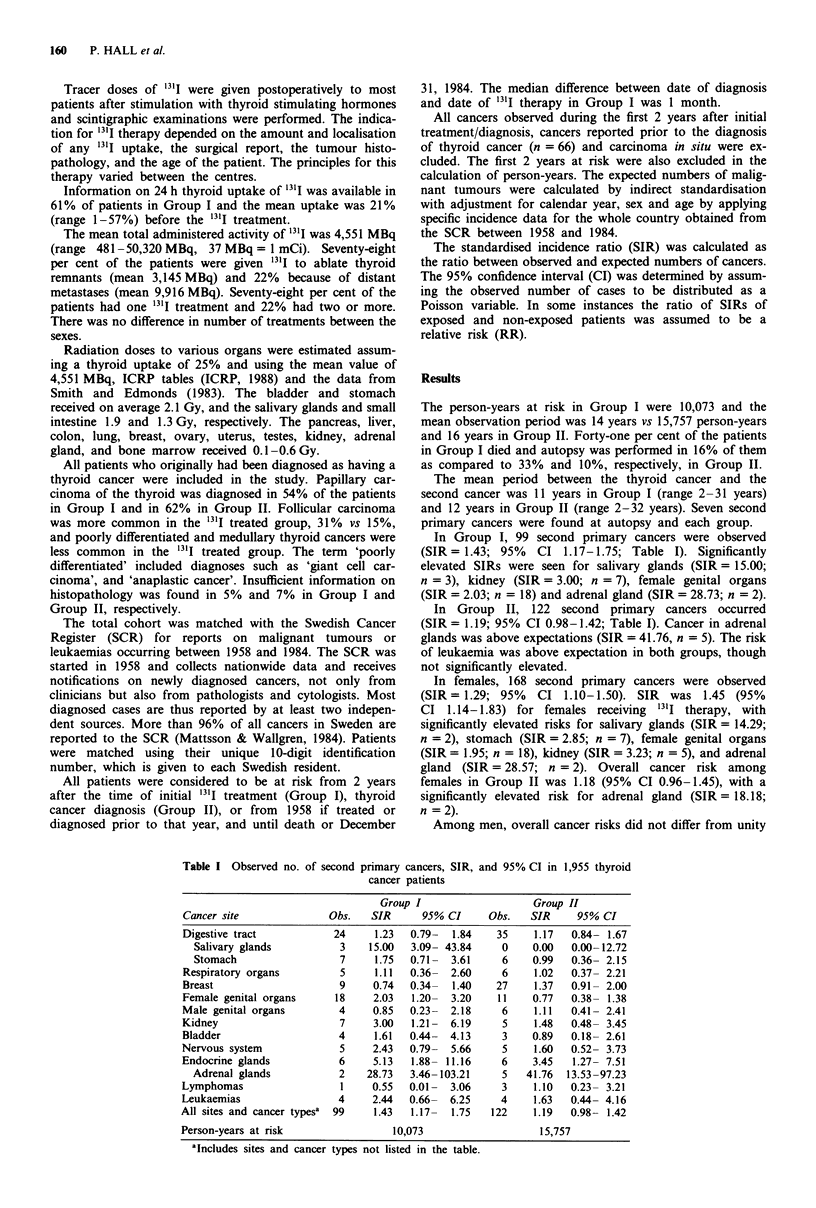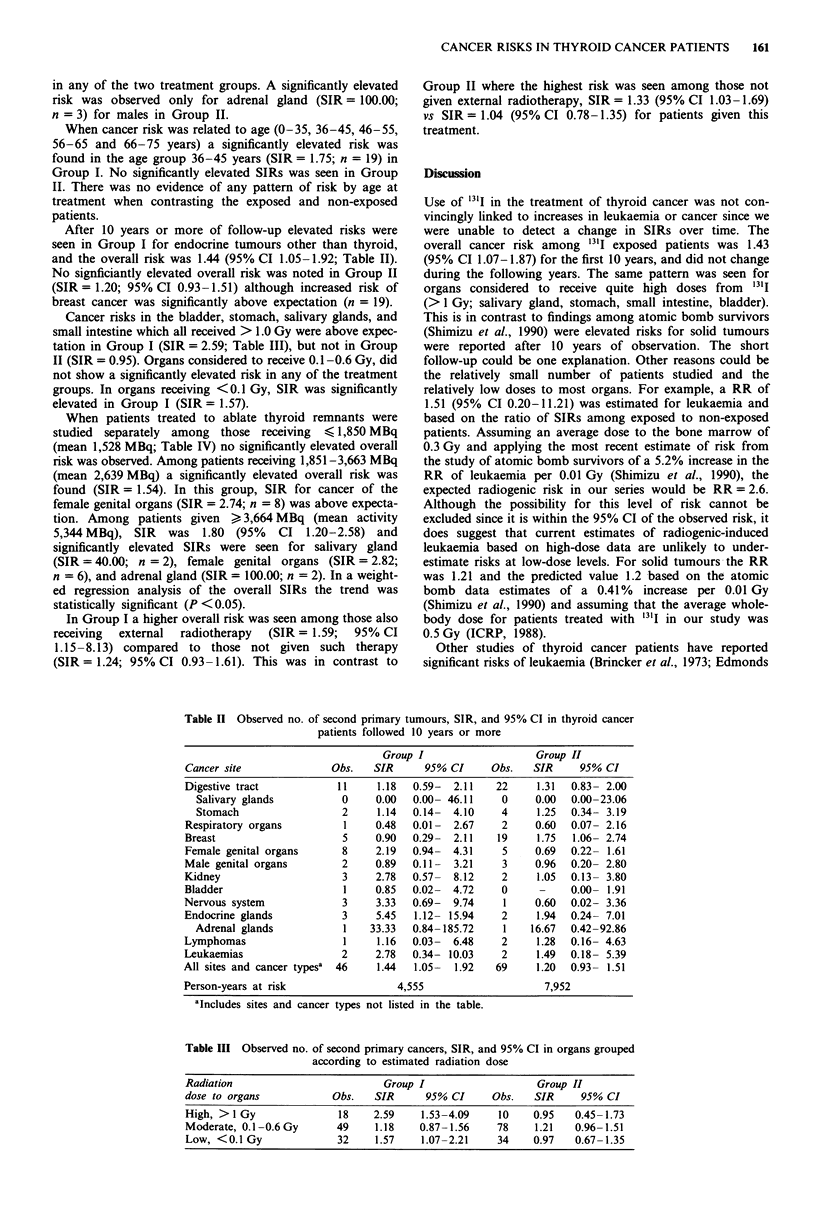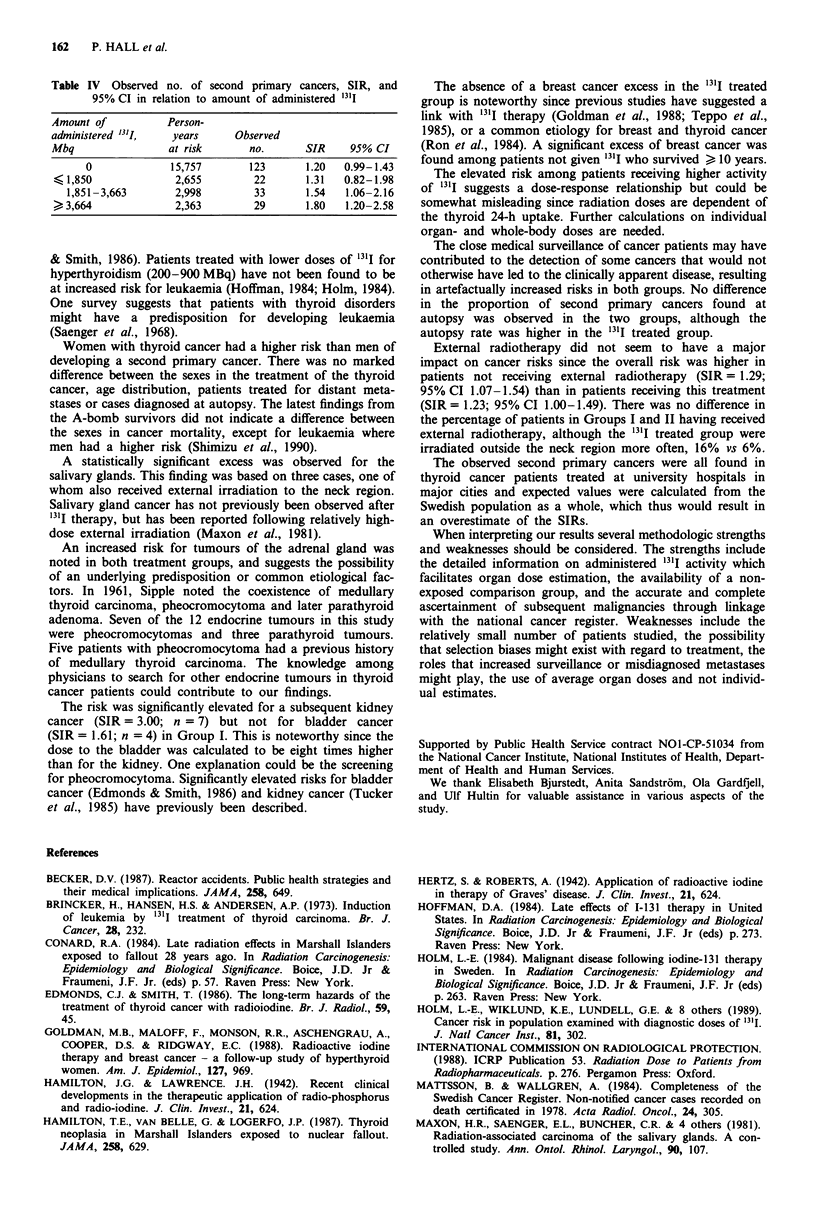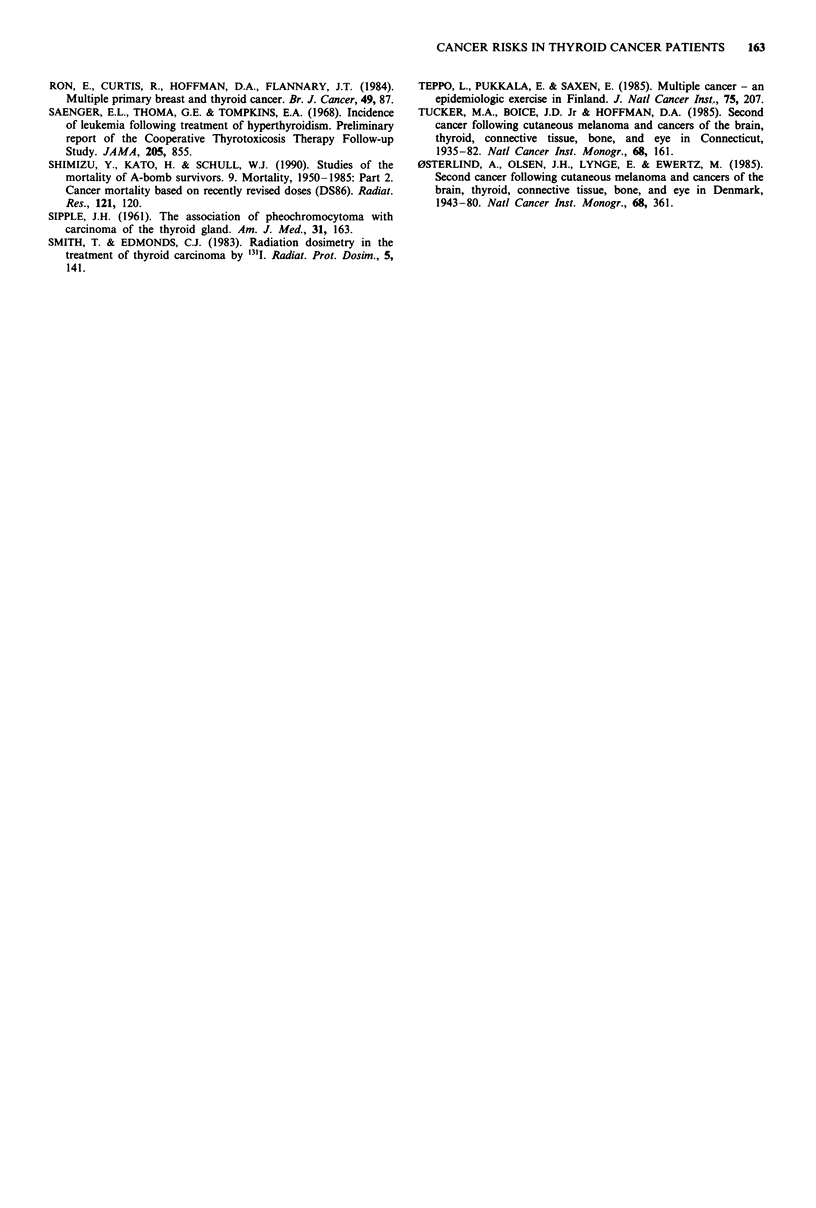Abstract
Cancer risks were studied in 834 thyroid cancer patients given 131I (4,551 MBq, average) and in 1,121 patients treated by other means in Sweden between 1950 and 1975. Record-linkage with the Swedish Cancer Register identified 99 new cancers more than 2 years after 131I therapy [standardised incidence ratio (SIR) = 1.43; 95% confidence interval (CI) 1.17-1.75] vs 122 (SIR = 1.19; 95% CI 0.88-1.42) in patients not receiving 131I. In females treated with 131I overall SIR was 1.45 (95% CI 1.14-1.83) and significantly elevated were noted for tumours of the salivary glands, genital organs, kidney and adrenal gland. No elevated risk of a subsequent breast cancer or leukaemia was noted. SIR did not change over time, arguing against a strong radiation effect of 131I. Organs that were estimated to have received more than 1.0 Gy had together a significantly increased risk of a subsequent cancer following 131I treatment (SIR = 2.59; n = 18). A significant trend was seen for increasing activities of 131I with highest risk for patients exposed to greater than or equal to 3,664 MBq (SIR = 1.80; 95% CI 1.20-2.58). No specific cancer or group of cancers could be convincingly linked to high-dose 131I exposures since SIR did not increase after 10 years of observation. However, upper confidence intervals could not exclude levels of risk that would be predicted based on data from the study of atomic bomb survivors. We conclude that the current practice of extrapolating the effects of high-dose exposures to lower-dose situations is unlikely to seriously underestimate radiation hazards for low LET radiation.
Full text
PDF




Selected References
These references are in PubMed. This may not be the complete list of references from this article.
- Becker D. V. Reactor accidents. Public health strategies and their medical implications. JAMA. 1987 Aug 7;258(5):649–654. doi: 10.1001/jama.258.5.649. [DOI] [PubMed] [Google Scholar]
- Brincker H., Hansen H. S., Andersen A. P. Induction of leukemia by 131-I treatment of thyroid carcinoma. Br J Cancer. 1973 Sep;28(3):232–237. doi: 10.1038/bjc.1973.142. [DOI] [PMC free article] [PubMed] [Google Scholar]
- Edmonds C. J., Smith T. The long-term hazards of the treatment of thyroid cancer with radioiodine. Br J Radiol. 1986 Jan;59(697):45–51. doi: 10.1259/0007-1285-59-697-45. [DOI] [PubMed] [Google Scholar]
- Goldman M. B., Maloof F., Monson R. R., Aschengrau A., Cooper D. S., Ridgway E. C. Radioactive iodine therapy and breast cancer. A follow-up study of hyperthyroid women. Am J Epidemiol. 1988 May;127(5):969–980. doi: 10.1093/oxfordjournals.aje.a114900. [DOI] [PubMed] [Google Scholar]
- Hamilton T. E., van Belle G., LoGerfo J. P. Thyroid neoplasia in Marshall Islanders exposed to nuclear fallout. JAMA. 1987 Aug 7;258(5):629–635. [PubMed] [Google Scholar]
- Holm L. E., Wiklund K. E., Lundell G. E., Bergman N. A., Bjelkengren G., Ericsson U. B., Cederquist E. S., Lidberg M. E., Lindberg R. S., Wicklund H. V. Cancer risk in population examined with diagnostic doses of 131I. J Natl Cancer Inst. 1989 Feb 15;81(4):302–306. doi: 10.1093/jnci/81.4.302. [DOI] [PubMed] [Google Scholar]
- Mattsson B., Wallgren A. Completeness of the Swedish Cancer Register. Non-notified cancer cases recorded on death certificates in 1978. Acta Radiol Oncol. 1984;23(5):305–313. doi: 10.3109/02841868409136026. [DOI] [PubMed] [Google Scholar]
- Maxon H. R., Saenger E. L., Buncher C. R., Thomas S. R., Kereiakes J. G., Shafer M. L., McLaughlin C. A. Radiation-associated carcinoma of the salivary glands. A controlled study. Ann Otol Rhinol Laryngol. 1981 Mar-Apr;90(2 Pt 1):107–108. doi: 10.1177/000348948109000202. [DOI] [PubMed] [Google Scholar]
- Osterlind A., Olsen J. H., Lynge E., Ewertz M. Second cancer following cutaneous melanoma and cancers of the brain, thyroid, connective tissue, bone, and eye in Denmark, 1943-80. Natl Cancer Inst Monogr. 1985 Dec;68:361–388. [PubMed] [Google Scholar]
- Ron E., Curtis R., Hoffman D. A., Flannery J. T. Multiple primary breast and thyroid cancer. Br J Cancer. 1984 Jan;49(1):87–92. doi: 10.1038/bjc.1984.13. [DOI] [PMC free article] [PubMed] [Google Scholar]
- Saenger E. L., Thoma G. E., Tompkins E. A. Incidence of leukemia following treatment of hyperthyroidism. Preliminary report of the Cooperative Thyrotoxicosis Therapy Follow-Up Study. JAMA. 1968 Sep 16;205(12):855–862. [PubMed] [Google Scholar]
- Shimizu Y., Kato H., Schull W. J. Studies of the mortality of A-bomb survivors. 9. Mortality, 1950-1985: Part 2. Cancer mortality based on the recently revised doses (DS86). Radiat Res. 1990 Feb;121(2):120–141. [PubMed] [Google Scholar]
- Teppo L., Pukkala E., Saxén E. Multiple cancer--an epidemiologic exercise in Finland. J Natl Cancer Inst. 1985 Aug;75(2):207–217. [PubMed] [Google Scholar]
- Tucker M. A., Boice J. D., Jr, Hoffman D. A. Second cancer following cutaneous melanoma and cancers of the brain, thyroid, connective tissue, bone, and eye in Connecticut, 1935-82. Natl Cancer Inst Monogr. 1985 Dec;68:161–189. [PubMed] [Google Scholar]


